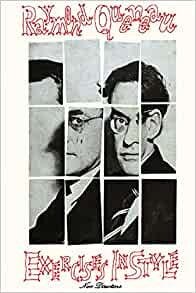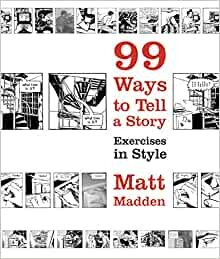Introduction
A good way of improving your writing skills is to try reworking texts into a completely different style or genre. To some extent this overlaps with parody writing, which I intend to explore in a separate post, but as a quick example, consider this. In Brand X Fiction, a collection of parodies of fiction writers, Leslie Johnson reduces Poe’s The Fall of the House of Usher to a classified advertisement.

If you’d like to see a recent example of my own parodies, you’ll find it here, a post in which I attempted to emulate the hardboiled prose style of Raymond Chandler):
Writing the same text in different styles is not quite the same as writing parodies, but it can be equally challenging — and rewarding. For example, writers are constantly being told not to write in the passive voice. But what difference does it make to the feel and meaning of the text? One way of finding out is to rewrite the text completely in the passive voice. Let me tell you, it’s quite an eye-opener. And what is especially eye-opening is that it’s not wholly bad.
And that raises another issue. We writers tend, I think, to accept the advice of well-established writers as if it’s the absolute truth. However, it may not be useful to us, or useful when taken out of context.
For example, take George Orwell’s rules for writing, which include injunctions such as never use a long word rather than a short one. Why not? If the long one is a better fit for what you are trying to say, you should definitely use it. (It’s worth bearing in mind that Orwell was concerned with political writing in particular, in which context his rules are very good for avoiding the obfuscation that politicians seem to be so adept at.)
Trying out different styles for the same piece of text helps you to see how the same event or idea can be given a completely different spin simply by changing the style in which it’s written.
I’d now like to review two books about this, and then present a couple of examples of my own “experiments in style”.
Exercises in Style
By Raymond Queneau

Anyone interested in the craft of writing should read this book, which is the one that alerted me to the idea of experimenting with styles in the first place. It’s not a primer, or dictionary, or anything of that nature. But it does exactly what it says on the tin. (If you’re not sure of the significance of that phrase, watch the advert below.)
The author is Raymond Queneau, one of the founders of the French writing movement called the Oulipo, which roughly translates as “workshop of potential literature”. What he did was write a simple story in which there’s a bit of an altercation between two people on a bus, an observation about the person’s dress, and the sighting of one of the people a little later in the day. That’s it: hardly a story. Hardly even an anecdote.
But what Queneau then does is to rewrite the story in numerous ways. For example, this is part of the “vanilla” story, what Queneau calls “Notation”:
Notation
On the S bus, in the rush hour. A chap of about twenty six, soft hat with a cord instead of a ribbon, neck too long, as if someone’s been tugging at it. People getting off.
Now here’s an extract from one of the rewrites:
Metaphorically
At the very heart of the day, tossed among the shoal of travelling sardines in a white-bellied beetle, a chicken with a long, featherless neck suddenly harangued one of their number, a peace-abiding one, and its parlance, moist with protest, was unleashed into the air.
Here’s an extract from a version called “Official Letter”:
Official letter
I beg to advise you of the following facts of which I happened to be the equally impartial and horrified witness.
Today, at roughly twelve noon, I was present on the platform of a bus which was proceeding up the rue de Courcelles in the direction of the Place Champerret. The aforementioned bus was fully laden- more than fully laden, I might even venture to say, since the conductor had accepted an overload of several candidates, without valid reason and actuated by an exaggerated kindness of heart which caused him to exceed the regulations and which, consequently, bordered on indulgence.
And here’s one more:
Mathematical
In a rectangular parallepiped moving along a line representing an integral solution of the second-order differential equation:
y”+PPTB(x)y’ +S=84
two homoids (of which only one, the homoid A, manifests a cylindrical element of length L>N encircled by two sine waves of ...
(That brought to my mind the Laputa book of Gulliver’s Travels, in which geometrical shapes are to be found everywhere!)
Not all of the “styles” work very well for me. For example, the dog Latin one does nothing for me. But most of them are instructive as well as humorous. It’s fascinating to see, for instance, what a difference it makes to the “feeling” of a piece of writing if it uses only the passive tense, or is rendered as an official report.
This book inspired me to write my own version of this sort of thing, which I’ve called experiments in style. I’ve learnt quite a lot from that endeavour, and I hope people who read those articles as I post them find them useful — and entertaining — as well.
99 Ways to tell a story
By Matt Madden

This is Matt Madden’s adaptation or response to Exercises in Style (see above). He takes a very simple incident, and depicts it in a variety of ways in cartoon form. The book is an example of Oubapo, which is a graphic form of Oulipo.
The book works in so many ways that it’s hard to know where to start. On a very basic level, it is hugely entertaining, because Madden embraces so many styles, both in terms of graphics and type. For example, Madden parodies or pays homage to the drawing styles of Jack Kirby, Herriman and Claire. As far as type is concerned, there is the political cartoon, public service announcement and even the Bayeaux Tapestry!
I may borrow some of Madden’s ideas for my own “Experiments in Style” project, though not the drawing aspects (as Clint Eastwood liked to say, “A man’s gotta know his limitations.”). But I love the idea of attempting to rewrite my own incident as an advertisement, or a “Spot the changes” competition!
For students of sequential art this book will serve as an excellent reference guide to what can be achieved. I especially find the filmic aspects interesting, such as long shots, zoom and other points of view.
I bought “99 Ways” several years ago, and still find it delightful to dip into. Highly recommended for anyone interested in Oulipo, Oubapo, graphic storytelling — or just a great read!
Book review
See also 99 Variations on a Proof (book review).
Experiments in Style
There now follows two of my own efforts in experimenting with styles. They’ve been published before, but either elsewhere or behind a paywall. I’ve collated them in this post so that they’re both in one place and freely available. (You’ll find the complete list of these experiments here: Index.)
The basic story is one in which I banged my head, and the consequences of that. Let’s start with that one, which serves, in effect, as a template for the others.
A bang on the head (template)
In the middle of the night, I woke up (if you can call being semi-conscious being awake), walked purposefully towards the door to go to the bathroom — and almost knocked myself out.
The reason was that in the twin states of entire darkness and semi-somnambulance I was facing in a different direction from the one I thought I was facing. As a result, instead of walking through the door, I tried to walk through the wall.
The next few days brought nausea and headaches. After much prevarication I went to Accident and Emergency, where I waited petrified among people for whom “social distancing” means not quite touching you, and who wore their masks as a chin-warmer.
An hour and a half later I emerged into the twilight, secure in the knowledge that I had nothing more serious than mild concussion. I failed to do much writing, but I was pleased to have read a further 17% of my book.
A bang on the head as a children’s cautionary tale, in rhyming couplets

Terry arose in the middle of the night
But didn’t bother to use the light.
And so, instead of walking through the door,
He hit the wall — and then the floor.
“Oh dear”, he cried, “I must confess
I’m not feeling at my best.”
And for the next depressing days
Had a headache and was in a haze.
“Enough!”, said his wife. “You’ve got concussion.
Off to hospital now — no discussion!”
So Terry wended his way to A & E.
“Alas, alack”, he sighed, and “Woe is me.”
No-one there had worn a mask.
“Keep your distance”, he cried. “That’s all I ask!”
The doctor looked into his eyes
And banged his elbows and pressed his thighs.
“No harm done, but take it easy.
For a week or so you might feel queasy.”
Then Terry strode into the night.
“Hip hooray”, he shouted. “I’m alright!
I’ve done no work but read a bit.
It’s all my fault though. What a twit!”
And so dear reader I’ll say nothing more,
Except: “Walls don’t open: use the door!”
I hope you enjoyed reading this. As you can see, my new version keeps to the basic facts and structure of the original story, but in a completely different way.
What follows next is a completely different take on this….
A bang on the head in the style of a badly written science fiction story
At the height of the nighttide, my somnochip activated itself, so I donned my hoversandals and glided purposefully towards the portal to go to the ablution centre — and almost temporarily deactivated myself.
The reason was that in the twin states of entire darkness and semi-somnambulance my gyroscopic implant seemed to be malfunctioning, and therefore I was facing in a different direction from the one I thought I was facing. As a result, instead of gliding through the portal, I tried to pass through the cubicle partitions.
(As you know, since The Event, all citizens have been obliged to wear implants of various types. These monitor and maintain our bodies and minds. At first, there were riots about privacy and concerns over The Masters throwing a switch and placing an individual in a state of enforced hybernation while he or she underwent re-education therapy. According to my memory implants, such a thing has never happened, and therefore all such fears have proven to be unfounded.)
The next few diurnal cycles brought nausea and headaches. Although my monitor displayed no unusual cranial activity, after much prevarication I ordered a robocab and went to the Medicomplex, where I waited petrified among people for whom “social distancing” means not quite touching you, and who wore their masks as a chin-warmer.
Ninety minutes later I emerged into the twilight, secure in the knowledge that I had nothing more serious than a mild impairment of my cortext functioning. I failed to do much writing, but I was pleased to have imbibed a further 17% of my book implant.
Commentary
This has quite a few elements of what I regard as bad science fiction writing, namely:
Made up words. Why would an automatic taxi be called a robocab? Why would night time become nighttide? Why would a sleep implant (whatever that is) be called a somnochip? I read a sci fi story recently in which the robot teacher was called a roboteach, and the school was called the eduarena. Schools have been knowns as schools for thousands of years. Why would anyone invent such an ugly word as eduarena, and how would it ever come to be adopted? (These kind of inventions, in the context of science fiction, are known as “tropes”. More generally, a trope is a convention of theme associated with a particular genre. For example, in blues songs the train always leaves at midnight; in hardboiled fiction there is usually a beautiful woman. I would suggest these are tropes.)
Exposition. Nobody in real life says things like “As you know, in 1939 there was a war called World War Two…”, but characters in badly-written science fiction stories do so all the time. (This sort of thing is called an “infodump”.)
Made up events. What is or was The Event? If we’re all supposed to know about it, why the exposition (see above) of its aftermath? If we need the exposition though, why not explain what The Event was?
In fairness, many badly-written science fiction stories have survived because they have a great central idea, or a really good plot device. So bad writing is not necessarily a barrier to longevity!
I hope you enjoyed reading this: please click on the heart if you did. And do consider becoming a premium subscriber: it would mean a lot to my bank manager.
Please note: I’m maintaining an index of the styles in which I’ve written this story.






Terry, This post not only made me laugh, it also made me think--always a good thing. And it reminded of this line I love to repeat: "If there are 12 rules, the 13th rule is: Break All the Rules. But you gotta know the rules to break them." Love your post! xo ~Mary
I once ran into a tree on Halloween. Concussions R U. My black cat mask fell over my eyes as I was cat-Ching up with fellow revilers. Writing reminds me of Lewis Carrol’s “Youhave to run twice as fast just to stay in one place.”